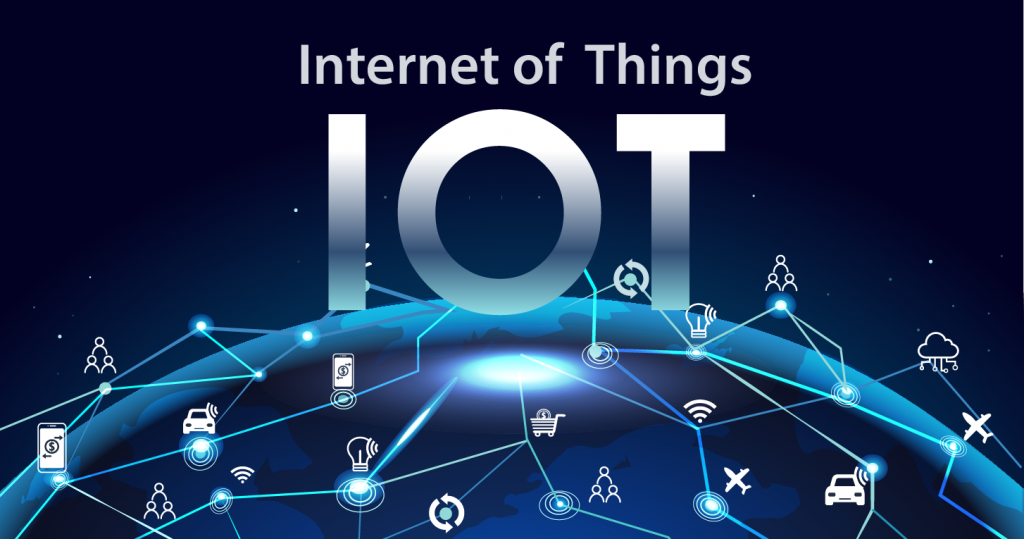What is the internet of things or IoT? IoT refers to interconnected computing devices, mechanical and digital machines, objects, animals or people with unique identifiers (UIDs) and the ability to transfer data over a network without human-to-human or human-to-computer interaction.
What are the examples for internet of things? It can be anything, any natural or man made object that assigned with an Internet Protocol (IP) address and has ability to transfer data over network. For example a person with a heart monitor implant, a farm animal with a biochip transponder, an automobile with built-in sensors to alert the driver when tire pressure is low. Many industries and companies are using internet of things technology to improve their efficiency and value of business. It also helped to give better service to their customers.
How does IoT work?
A internet of things system consists with web-enabled smart devices. These devices use embedded systems like processors, sensors and communication hardware. Those devices collect data from their environment and send them to the cloud to be analyzed or analyzed them locally. They connect to an IoT gateway or other edge device for this data sharing process.
Sometimes these devices connect with other devices and get information from them. Then they work according to those information. The most important part of IoT is these devices work without human interaction. But humans can give them instructions what they should do and access its data. These devices use specific IoT applications. And also they using the connectivity, networking and communication protocols for making data collecting processes. Artificial intelligence (AI) and machine learning helps to make this process easier.
Why is internet of things important?
The internet of things has become one of important technology in day to day life. It helps people to gain complete control over their lives and have a starter life. Not only people but also organizations and companies need IoT.
Internet of things helps businesses to discover how their systems work and deliver insights into everything related business from the performance of machines to supply chain and logistics operations. IoT helps companies in different ways. Such as automate their processes and reduce labor costs, reduce the waste, improves service delivery, making manufacture and deliver goods with low cost, offer transparency into customer transactions and so on.
What are the benefits of internet of things to organizations
It gives many benefits to organizations. Those can be industry-specific benefits or common benefits of any industry. Look at below examples.
- monitor overall business processes.
- IoT improve the customer experience (CX).
- save both time and money.
- Improve employee productivity
- integrate business models
- IoT make better business decisions.
- Improve more revenue.
Any business can approach their business by using IoT. It gives chance to rethink about their strategies and some tools to improve them. Any businesses can get above benefits without a effect of what kind a business is it. It may be manufacturing, transportation and utility organizations, all of them can have those benefits.
There are some industry specific benefits also. For example, IoT helps agriculture industry in a different way. Sensors collect data about humidity, rainfall, temperature and soil content and many more factors. So, farmers can use the information for make improve their productivity. Infrastructure industry can use IoT technology also. For example sensors can use for monitor events or changes within structural buildings, and other infrastructure. Those information will save the cost and time. They will improve the quality-of-life workflow changes and make paperless workflow also.
A home automation business can get many benefits from IoT also. For example it is useful to monitor and manipulate mechanical and electrical systems in a building. Not only those industry but also any kind of business like healthcare, finance, retail and manufacturing, can use IoT and get benefits.
What are the pros and cons of IoT?
There are some advantages and disadvantages of using internet of things. Firstly let’s take a look at some advantages.
- You can access information from anywhere at any time using any device.
- IoT improve communication between connected electronic devices.
- It save both money and day because of transferring data packets over a connected network.
- Automating tasks help to improve the quality of a business’s. And also it reduces the need for human intervention for business.
IoT gives some disadvantages also.
- The potential of stealing confidential information by a hacker is improved. If a business uses many connected devices and shares many information, they are in this risk.
- It’s challenging to collect and manage their data from connected massive number of devices. Some business use millions of devices and they face this issue.
- If there’s a bug in a system, every connected device can become corrupted.
- It’s hard for devices from different manufacturers to communicate with each devices. Because there is no any international standard it.
IoT standards and frameworks
There are many IoT standards.
| Standard | Introduction | Usage |
| IPv6 over Low-Power Wireless Personal Area Networks (6LoWPAN) | an open standard and it was defined by the Internet Engineering Task Force (IETF) | enables low-power radio to communicate to the internet. Such as Bluetooth Low Energy (BLE) and Z-Wave (for home automation). |
| ZigBee | a low-power and low-data rate wireless network which based on the Institute of Electrical and Electronics Engineers (IEEE) 802.15.4 standard | used mainly in industrial settings. This standard enables smart objects to work securely on any network and understand each objects. |
| LiteOS | a Unix-like operating system [OS) | serves as a smart device development platform also. This standard supports for smartphones, intelligent manufacturing applications, wearables, smart homes and the internet of vehicles (IoV). |
| OneM2M | a machine-to-machine service layer. This layer can be embedded in hardware and software to connect devices. | OneM2M was created to develop reusable standards that enable IoT applications in different industries for communication |
| Data Distribution Service (DDS) | Object Management Group (OMG) created this standard | helps to get scalable, real-time and high-performance M2M communication. |
| Advanced Message Queuing Protocol (AMQP) | an open source standard for asynchronous messaging by wire. | enables encrypted messaging between organizations and applications. used in client-server messaging. used in IoT device management. |
| Constrained Application Protocol (CoAP) | a protocol designed by the IETF | specifies how low-power, compute-constrained devices can operate in the internet of things |
| Constrained Application Protocol (CoAP) | IETF create this standard | Help to low-power and compute-constrained devices to operate in IoT. |
| Long Range Wide Area Network (LoRaWAN) | a protocol for WANs | Supports huge networks, like smart cities, with large number of low-power devices. |
IoT frameworks are given below
| Framework | Introduction | Usage |
| Amazon Web Services (AWS) IoT | a cloud computing platform for IoT which released by Amazon. | Enable smart devices to connect and interact with the AWS cloud and other devices, easily and securely. |
| Arm Mbed IoT | A platform to develop apps on Arm microcontrollers. | [Provide a connected, scalable and secure environment for devices by integrating Mbed tools and services |
| Microsoft’s Azure IoT Suite | platform consists with a set of services. | Enable to interact with and receive data from IoT devices Perform many operations over data (multidimensional analysis, transformation and aggregation) Visualize operations in a way which suits for business. |
| Google’s Brillo/Weave | Platform for the implementation of IoT applications. Consists with two main backbones. They are Brillo (Android-based OS ) and Weave ( IoT-oriented communication protocol ). | Brillo uses for the development of embedded low-power devices. Weave uses as a communication language between the cloud and the device. |
| Calvin | An open source IoT platform which designed by Ericsson. Include a development framework and a runtime environment. | Build and manage distributed applications which enable devices to talk to each device. Development framework helps to application development. Runtime environment handle the running of the application. |
IoT security and privacy issues
Internet of things use many devices and works with billions of data. But the most important thing is all the data must be secured. Therefore security and privacy are important concerns in IoT. One of most recent attack was Mirai. It happened in 2016. Mirai was a a botnet that infiltrated domain name server provider Dyn. It took down many websites for some time period. Attackers have gotten access to the network by exploitingIoT devices that were poorly secured.
IoT devices are connected closely to each other. Therefore hackers can manipulate all the data by exploiting one vulnerability. If device manufacturers do not update their devices often, there is a more chance to get attacked. Connected devices in IoT ask their users to input personal information like their name, age, phone number, email and their social media account details. Those details are useful for hackers.
If you are thinking hackers are the only threat, but it’s not. There are many more. Companies that make and distribute IoT devices can use consumer’s personal details and they can even sell them to third party. Therefore privacy is need to be concern. And also there is a risk to critical infrastructure like electricity, transportation and financial services.
What is the history of IoT?
Kevin Ashton, co-founder of the Auto-ID Center is the first person who mentioned the internet of things. He said about it in a presentation about Procter &Gamble (P&G) in 1999. He wanted to get radio frequency ID (RFID) to the attention of P&G’s senior management. MIT professor Neil Gershenfeld gave a clear idea about where IoT was headed from his book of When Things Start to Think, which appeared in 1999.
Even though Ashton mentioned it first, the idea of connected devices had come since the 1970s. It took decades and got improved until internet of things became a part of human life as we experienced today.

Meet Jane Madison, a tech aficionado armed with a Bachelor’s degree in Computer Science, and the creative force behind the written tapestry at Creativeoutrank LLC.
With a solid foundation in Computer Science, Jane seamlessly blends her technical acumen with a flair for storytelling. Currently contributing to Creativeoutrank LLC and their websites, her writing spans the diverse realms of technology.
Jane’s articles are a journey through the ever-evolving landscape of technology, offering insights into the latest trends and innovations. Beyond the confines of code, she delves into the dynamic world of tech, providing a unique perspective on its impact on our lives.
Join Jane Madison on this literary expedition, where every piece is a fusion of technology and the captivating scenes that unfold before her discerning eyes.
